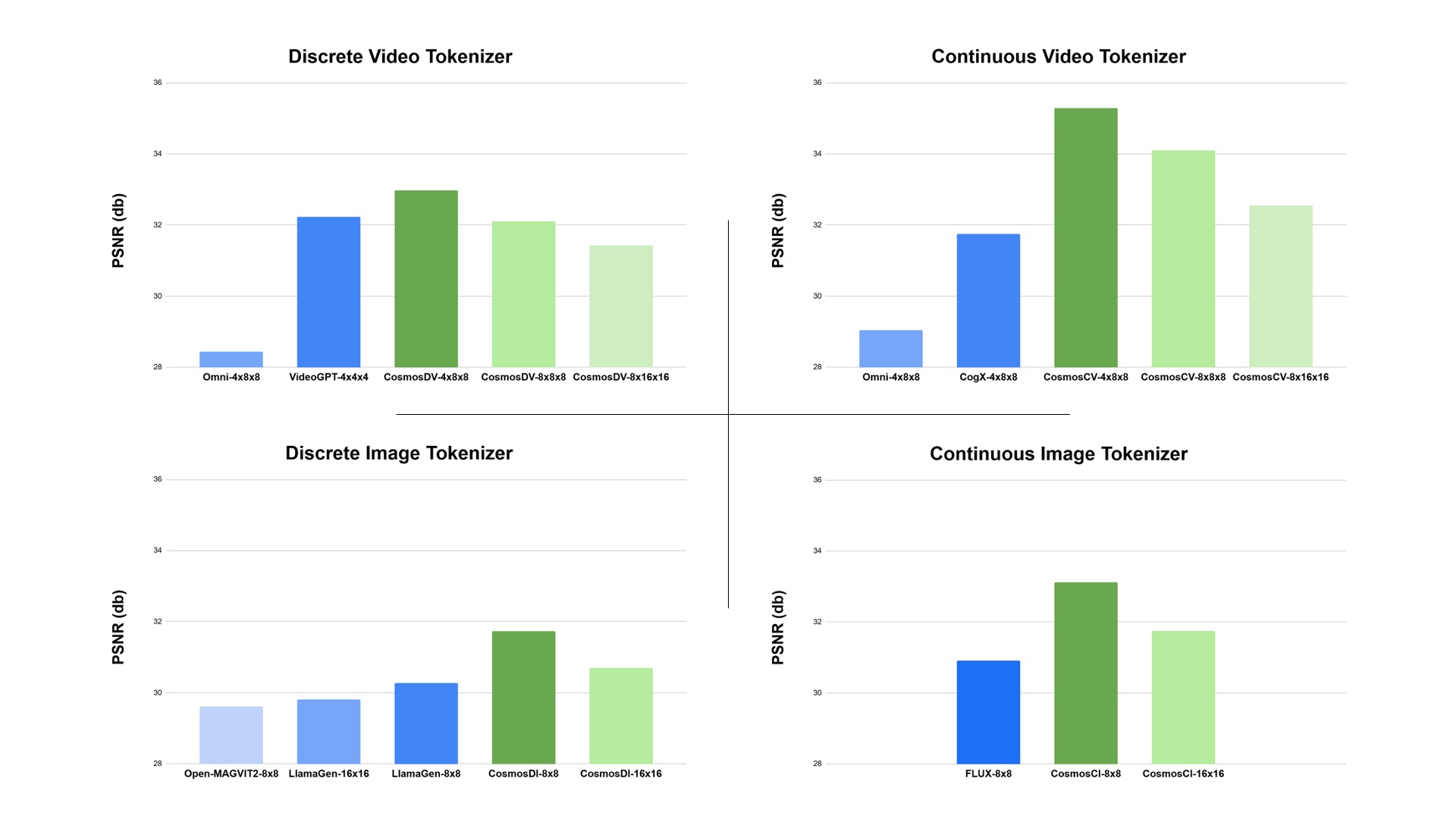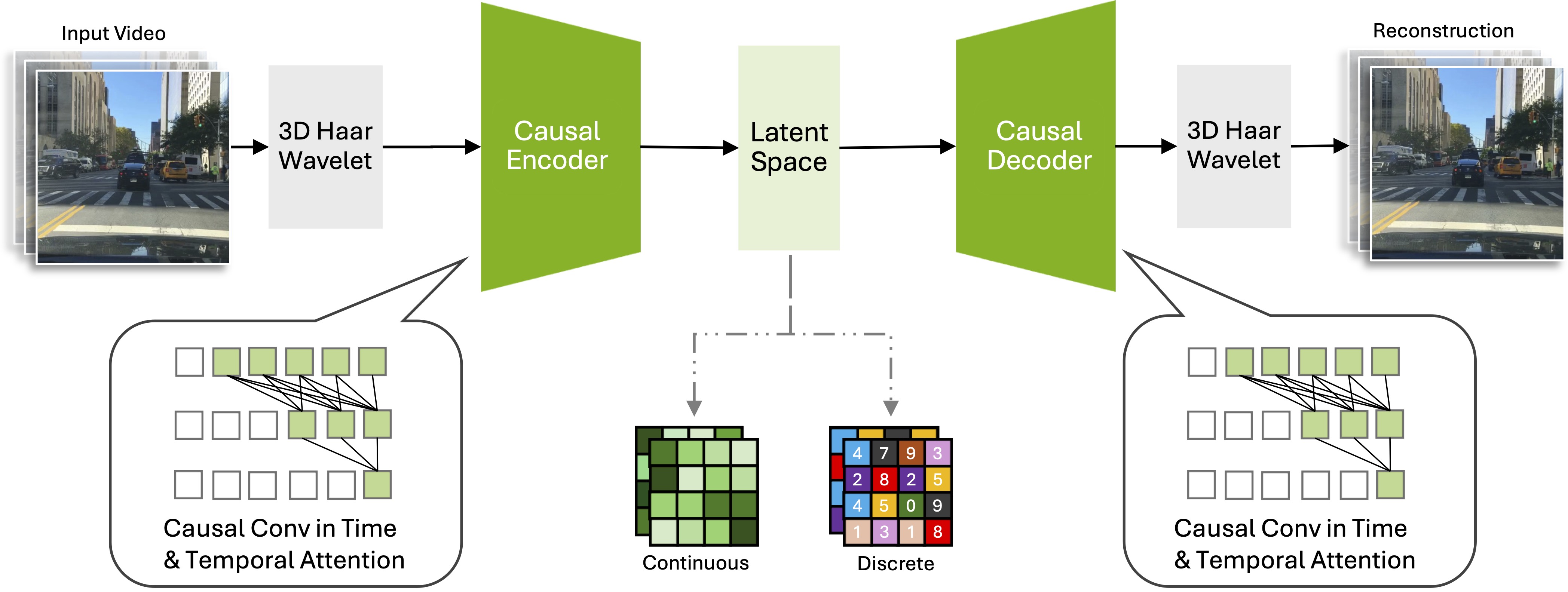Website | NVIDIA Blog | Hugging Face | YouTube | TokenBench
We present Cosmos Tokenizer, a suite of image and video tokenizers that advances the state-of-the-art in visual tokenization, paving the way for scalable, robust and efficient development of large auto-regressive transformers (such as LLMs) or diffusion generators. This repo hosts the inference codes and shares pre-trained models for the different tokenizers. Please check out our demo video.
| Continuous ( C ) | Discrete ( D ) | |
|---|---|---|
| Images ( I ) | Cosmos-Tokenizer-CI | Cosmos-Tokenizer-DI |
| Videos ( V ) | Cosmos-Tokenizer-CV | Cosmos-Tokenizer-DV |
Given an image or video, Cosmos Tokenizer outputs either continuous latents or discrete tokens. Cosmos Tokenizer achieves spatial compression rates of 8x or 16x and temporal compression factors of 4x or 8x, resulting in a total compression factor of up to 2048x (=8x16x16). Cosmos Tokenizer delivers 8x more total compression than state-of-the-art (SOTA) methods, while simultaneously maintaining higher image quality and running up to 12x faster than the best available SOTA tokenizers.
- Models: The models are licensed under NVIDIA Open Model License. Under the NVIDIA Open Model License, NVIDIA confirms:
- Models are commercially usable.
- You are free to create and distribute Derivative Models.
- NVIDIA does not claim ownership to any outputs generated using the Models or Derivative Models.
- GitHub Code: This repository is licensed under the Apache 2.0 license.
- Clone the source code
git clone https://github.com/NVIDIA/Cosmos-Tokenizer.git
cd Cosmos-Tokenizer
- Install dependencies
pip3 install -r requirements.txt
apt-get install -y ffmpeg
Preferably, build a docker image using the provided Dockerfile
docker build -t cosmos-docker -f Dockerfile .
# You can run the container as:
docker run --gpus all -it --rm -v /home/${USER}:/home/${USER} \
--workdir ${PWD} cosmos-docker /bin/bash
We host 10 Cosmos-Tokenizer models on Hugging Face, with the following model names. You can use this snippet to download:
from huggingface_hub import login, snapshot_download
import os
login(token="<YOUR-HF-TOKEN>", add_to_git_credential=True)
model_names = [
"Cosmos-Tokenizer-CI8x8",
"Cosmos-Tokenizer-CI16x16",
"Cosmos-Tokenizer-CV4x8x8",
"Cosmos-Tokenizer-CV8x8x8",
"Cosmos-Tokenizer-CV8x16x16",
"Cosmos-Tokenizer-DI8x8",
"Cosmos-Tokenizer-DI16x16",
"Cosmos-Tokenizer-DV4x8x8",
"Cosmos-Tokenizer-DV8x8x8",
"Cosmos-Tokenizer-DV8x16x16",
]
for model_name in model_names:
hf_repo = "nvidia/" + model_name
local_dir = "pretrained_ckpts/" + model_name
os.makedirs(local_dir, exist_ok=True)
print(f"downloading {model_name}...")
snapshot_download(repo_id=hf_repo, allow_patterns=["*.jit"], local_dir=local_dir)Under the checkpoint repository pretrained_ckpts/{model_name}, we provide the encoder, decoder and the full autoencoder JIT models.
├── Cosmos-Tokenizer-DV4x8x8/
│ ├── encoder.jit
│ ├── decoder.jit
│ ├── autoencoder.jitYou can use the following example commands to encode and decode images or videos.
For each, the same command works for both continuous and discrete tokenization. Simply provide the proper JIT-compiled ckpt to checkpoint_enc, checkpoint_dec, or the full autoencoder ckpt to checkpoint.
import torch
from cosmos_tokenizer.video_lib import CausalVideoTokenizer
model_name = "Cosmos-Tokenizer-CV4x8x8"
input_tensor = torch.randn(1, 3, 9, 512, 512).to('cuda').to(torch.bfloat16) # [B, C, T, H, W]
encoder = CausalVideoTokenizer(checkpoint_enc=f'pretrained_ckpts/{model_name}/encoder.jit')
(latent,) = encoder.encode(input_tensor)
torch.testing.assert_close(latent.shape, (1, 16, 3, 64, 64))
# The input tensor can be reconstructed by the decoder as:
decoder = CausalVideoTokenizer(checkpoint_dec=f'pretrained_ckpts/{model_name}/decoder.jit')
reconstructed_tensor = decoder.decode(latent)
torch.testing.assert_close(reconstructed_tensor.shape, input_tensor.shape)The latent will have the shape (1, 16, 3, 64, 64), where the first of the three latents represents the first frame, and C=16 is the number of channels of the latent.
import torch
from cosmos_tokenizer.video_lib import CausalVideoTokenizer
model_name = "Cosmos-Tokenizer-DV4x8x8"
input_tensor = torch.randn(1, 3, 9, 512, 512).to('cuda').to(torch.bfloat16) # [B, C, T, H, W]
encoder = CausalVideoTokenizer(checkpoint_enc=f'pretrained_ckpts/{model_name}/encoder.jit')
(indices, codes) = encoder.encode(input_tensor)
torch.testing.assert_close(indices.shape, (1, 3, 64, 64))
torch.testing.assert_close(codes.shape, (1, 6, 3, 64, 64))
# The input tensor can be reconstructed by the decoder as:
decoder = CausalVideoTokenizer(checkpoint_dec=f'pretrained_ckpts/{model_name}/decoder.jit')
reconstructed_tensor = decoder.decode(indices)
torch.testing.assert_close(reconstructed_tensor.shape, input_tensor.shape)The indices will have the shape (1, 3, 64, 64) and contain integral values in the range [1..64K], where the first of the three integral maps represents the first frame.
The codes will contain the pre-quantization continuous latent with shape (1, 6, 3, 64, 64), where C=6 represents the number of FSQ levels.
The following instructions run the various tokenizer on the example image and video provided in test_data/.
- Autoencoding images. Accepts an input image, and outputs a reconstruction of the image obtained by decoding the encoded latents.
# Autoencoding images using `Cosmos-CI` with a compression rate of 8x8.
model_name="Cosmos-Tokenizer-CI8x8"
python3 -m cosmos_tokenizer.image_cli \
--image_pattern 'test_data/image.png' \
--checkpoint_enc pretrained_ckpts/${model_name}/encoder.jit \
--checkpoint_dec pretrained_ckpts/${model_name}/decoder.jitIf --output_dir is not specified, you can find the reconstructed image at test_data/reconstructions/image.png.
- Autoencoding videos. Accepts an input video, and outputs a reconstruction of the video obtained by decoding the encoded latents.
# Autoencoding videos using `Cosmos-DV` with a compression rate of 4x8x8.
model_name="Cosmos-Tokenizer-DV4x8x8"
python3 -m cosmos_tokenizer.video_cli \
--video_pattern 'test_data/video.mp4' \
--checkpoint_enc pretrained_ckpts/${model_name}/encoder.jit \
--checkpoint_dec pretrained_ckpts/${model_name}/decoder.jitIf --output_dir is not specified, then you can find the reconstructed video at test_data/reconstructions/video.mp4.
To run the tokenizers in native PyTorch, append your commands with --mode=torch.
In PyTorch mode, the model is constructed from the native network definition scripts, which requires providing additional arguments to configure the model for instantiation.
For example, to instantiate a Cosmos-DI with a spatial compression factor of 8, append the following command line arguments:
--mode=torch--tokenizer_type=DI--spatial_compression=8
Note that the --checkpoint_enc, --checkpoint_dec, and --checkpoint should still refer to JIT files.
The necessary state_dicts will be extracted from the loaded JIT models to initialize the weights of the constructed native PyTorch model.
# Autoencoding images using `Cosmos-DI` with a compression rate of 8x8.
model_name="Cosmos-Tokenizer-DI8x8"
python3 -m cosmos_tokenizer.image_cli \
--image_pattern 'test_data/*.png' \
--mode=torch \
--tokenizer_type=DI \
--spatial_compression=8 \
--checkpoint_enc pretrained_ckpts/${model_name}/encoder.jit \
--checkpoint_dec pretrained_ckpts/${model_name}/decoder.jitTo instantiate a Cosmos-CV with a temporal factor of 8 and a spatial compression factor of 8, append the following command line arguments:
--mode=torch--tokenizer_type=CV--temporal_compression=8--spatial_compression=8
# Autoencoding videos using `Cosmos-CV` with a compression rate of 8x8x8.
model_name="Cosmos-Tokenizer-CV8x8x8"
python3 -m cosmos_tokenizer.video_cli \
--video_pattern 'test_data/*.mp4' \
--mode=torch \
--tokenizer_type=CV \
--temporal_compression=8 \
--spatial_compression=8 \
--checkpoint_enc pretrained_ckpts/${model_name}/encoder.jit \
--checkpoint_dec pretrained_ckpts/${model_name}/decoder.jitQuantitative comparision of our tokenizer and previous tokenizers on DAVIS (Perazzi et al., 2016) dataset. Cosmos Tokenizer achieves state-of-the-art results. Even at higer compression rates (8x8x8 and 8x16x16), Cosmos Tokenizer outperforms previous methods, demonstrating excellent compression-quality trade-off.

Comparision of parameter counts and average encoding and decoding times per image or per video frame on a single A100 80GB GPU. Cosmos Tokenizer achieves 2x to 12x faster speeds than previous methods while maintaining smallest model sizes, demonstrating high tokenization efficiency.

TokenBench is a comprehensive benchmark that we have curated to standardize the evaluation of Cosmos-Tokenizer. It covers a wide variety of domains including robotic manipulation, driving, egocentric, and web videos. It consists of high-resolution, long-duration videos, and is designed to benchmark video tokenizers. We have made TokenBench publicly available at github.com/NVlabs/TokenBench.
Fitsum Reda, Jinwei Gu, Xian Liu, Songwei Ge, Ting-Chun Wang, Haoxiang Wang, Ming-Yu Liu
We would like to acknowledge the following projects where parts of the codes in the cosmos_tokenizer/modules folder is derived from:
